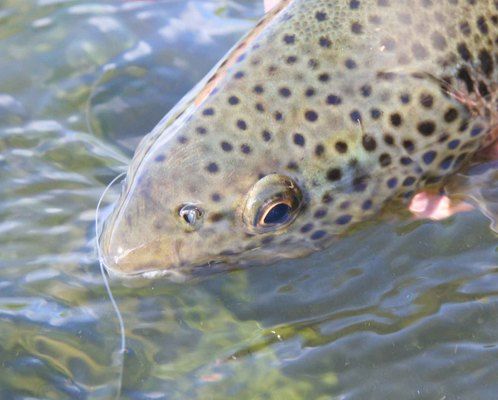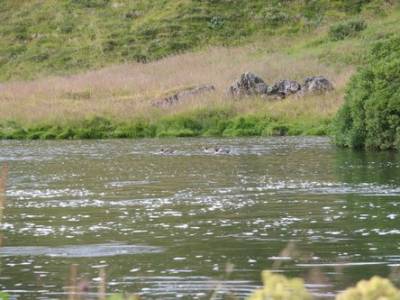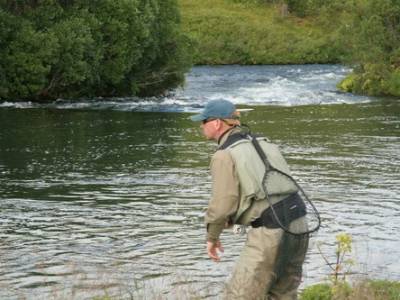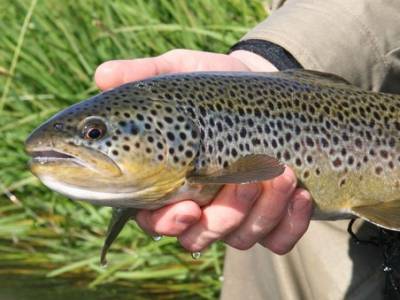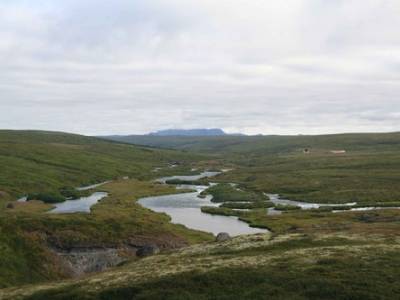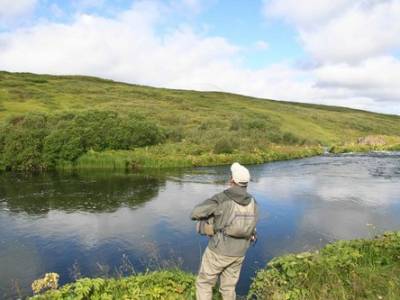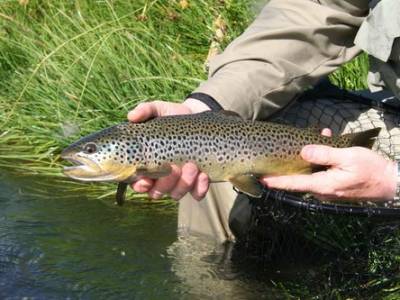Iceland, exploratory trip, August 2008……..
TROUT AT THE TOP OF A SALMON RIVER….one of the world’s finest dry fly waters.
Here is an extract from Howard’s recent article on the trip published in the January 2009 issue of Trout and Salmon magazine:
Story and images by Howard Taylor
If that well known brand of lager made a fly fishing trip then this would surely be it. A civilised and un-crowded country with stunning women, friendly people, superb cuisine, the most dramatic scenery and rich wildlife, a myriad rivers and lakes, all bathed in a soothing crisp artic light and only a short flight from London away… Sounds good?….It gets better. Then there’s the fishing…We know the country of Iceland is famous for the salmon who run the literally hundreds of rivers. I’m told salmon fishing is so important here that the top Icelandic salmon anglers are given a celebrity status. Just about every one of the near 300,000 population fishes for salmon, which explains why I was thrown a few quizzical looks when I announced I was in Iceland for the trout fishing. Nobody fishes for trout here I was told by my taxi driver in Reykjavik. I was to find out the Icelandic trout fishing remains relatively unexplored, which to a trout fan like myself sent shivers of anticipation from my reel seat to the tip ring!
From the capital, I took a short internal flight to the north of the island to fish one of the premier salmon rivers; the 61km long Laxa I Adaldal or Big Laxa, specifically for wild brown trout not salmon. I had it on good authority that this was the best dry fly wild trout river in the world! Surely an exaggerated claim? I was so excited with the prospect, I’d been preparing for months. I packed my boxes of dry flies into my fly vest, my 4 and 5 weight outfits with my two favourite Hardy reels, waders, boots etc. typical chalkstream kit. Worth remembering that all tackle taken into Iceland must be disinfected to protect against freshwater diseases. Either prior to you trip by your vet, or upon arrival in Keflavik (Reykjavik) airport.
Volcanic activity 2300 years ago and glacial action formed the upper reaches of this Laxa (literally “the salmon river") in Iceland’s northern volcanic zone. It left three thunderous waterfalls at the river’s halfway point, impassable to running salmon. This natural energy is now harnessed by a hydro-electric power station, complete with a modern salmon ladder; the salmon still don’t choose to run upstream and leave the more fertile 374 hectares of upper beats solely to the native brown trout. here they grow big, very big.
The unexplained phenomena that rivers flowing north into the Atlantic hold the largest salmon is substantiated by catches from the famous rivers of Russia and Norway and equally by Iceland’s south – north orientated Laxa I Adaldal. She is one of the rivers in Iceland to regularly boast rod caught salmon over the magical 20lbs and a big fish river above the dam too. Several double figure wild browns are caught on the upper trout beats each season and the Laxa’s secret is that it is lake fed. Lake fed rivers do not spate, so, to the salmon angler they are more predictable. And for the trout, the lake generates massive volumes of organic matter, the food source for the exceptionally high densities of suspension-feeding blackfly (simuliid) lavae. The larvae emerge from early June through to early August and when a hatch is on the trout go wild and the dry fly fishing is superb – perhaps the best in the world. For the remainder of the short, 90 day season, nymph and spider fishing hit the mark whilst the trout feed voraciously subsurface.
Upon arrival at Akureyri airport, I walked through to baggage collection where I was confronted by a large red haired gentleman who asked “Are you Howard?" For a second, I wasn’t sure if I’d done something wrong. It was Bjarni my guide who is not only a Viking of a man, he’s also the local policeman and THE trout guide of the upper Laxa. Bjarni grew up here and knows these beats intimately he told me his first memory of fishing was with his grandfather and thirty years on he is still fishing the same pools.
On sweeping smooth roads that hill-climbers dream of, we wound our way through a wilderness of volcanic peaks and glacial valleys, with small farms clinging to the kinder gradients. Our destination was a small hamlet containing a church, a few houses and Nes Lodge; the very comfortable accommodation of the Laxa I Adaldal’s salmon anglers. We arrived late evening and Bjarni showed me the beautiful salmon beats. Pools to die for and there, I watched one angler return a fresh cock fish he weighted at 12 kilos! We were off to a very good start.
I just couldn’t wait to wet a line. Bjarni said, If you think this is good wait till you see the upper trout beat tomorrow morning. I hardly slept with anticipation. After a hearty breakfast we set of up the river valley in Bjarni’s Land Rover. We rounded the penultimate corner and lake Myvatn unfolded before my eyes – a truly spectacular sight. This is designated a RAMSAR wetland bird site and is of global conservation importance before me lay a vast expanse of glassy water framed by northern Iceland’s imposing topography. Below the lake, like nothing I have seen before, the river flows in many channels, braided in its shallow valley, thus providing the trout with diverse aquatic habitats and anglers with some very varied fishing.
I liked that the beats are booked by half days intervals, so we jumped out at our beat for our first morning… and the black flies found us. I was worried they would take chunks out of me. Bjarni laughed, and pointed out that this was a very good sign indeed. Trout food he said. “Don’t eat them" as one flew down my throat! Still coughing I walked to the edge of the river and watched. Bjarni pointed with his large befreckled finger. The trout were rising very gently supping the fly from the surface. “Small fish?" I asked pointing at a subtle rise. “May be" he said with a smurk. We watched the beautiful water for a few moments more as a merlin shot into view and chased a tern, not hunting just playing, throwing in a stoop or two showing us what he could do just wonderful.
I pulled a black Klinkhammer from my box and Bjarni gave me the thumbs up. We passed three Icelandic trout fishermen on the river bank. I wondered why they were fishing sinking lines and coneheaded streamers in the middle of this major hatch. Bjarni shrugged his shoulders. Interestingly, streamers are successful but there are no other species of fish that inhabit this part of the river no baitfish, just trout, so why do they take a streamer?
We crossed a small carrier and peered over a grassy volcanic lump into a mirror smooth pool. There were fish rising everywhere. I guessed they were trout parr. I gently cast upstream to the nearest ripple and as my fly was sucked sub-surface, I struck. Volcano theme in mind; the water literally erupted as this monster trout launched skyward in a bid for freedom. My reel sang and my backing knot disappeared through the tip ring. “Heeelp" I yelled! What an astounding fight more like a bonefish than a trout breakneck acceleration that really took me by surprise. Three screeching runs and just as I was easing the fish over the brim of Bjarni’s net it lunged to the current again shaking its head angrily sending thumps down to the cork of the rod. Fifteen minutes after the first cast with my 4 weight I had a wild 4lb brownie on a size 16 dry fly it doesn’t get much better.
We fished the morning session from 8 until 2 on this beat and we claimed a dozen fish before visiting the trout lodge for lunch. The photos around the lodge walls showed anglers holding monster trout like the ferox leviathians of our Scottish Lochs. One print showed stomach contents of three ducklings and another a rat! No wonder they take streamers I thought proper Viking trout! For the afternoon session, 4 until 10pm we changed scenery to fish the beat just downstream.
Here the valley gets steeper and we sat on the ridge looking into the large river channel. From our vantage point we could see a couple of miles of river and pin point the rising fish from a distance a tactic Bjarni often uses. His passion is hunting surface feeding fish with a dry fly. Impatient, I thought of grabbing the rod from the Landrover’s mounts and running, winding up a cast as I went. Bjarni’s approach far more relaxed as he picked a handful of wild blueberries from the slope as we walked down. At the bottom I realised the river was deep with the same underwater profile as the valley above, it was too deep to wade and the bank behind me made a conventional cast impossible. I changed to a small CDC hopper, put mud on my tippet to sink it and rolled cast as far as I could keeping low and quiet. Following the fly with the rod tip, I threw in a little mend to prevent the fly dragging. As I did the fly moved an inch or two and bang! The fish hit me almost square and as I struck it zoomed down stream using the powerful current to its full advantage. My little chalkstream reel has no drag and my finger burnt as I thumbed the spool to slow the fish. I could do nothing and had to set off following downstream. “These trout are beserk" I said. Bjarni nodded, grinning as he watched me scrabbling over the basalt trying to fight the fish. Up close the water is crystal clear, but the fish are tricky to see because the river flows over the black laval rock and black sand. The sun made his flanks glint gold as we slid him towards the net a few minutes later. “He’s a big one" said Bjarni as he lifted his net out of the water, crystal droplets falling from the fish. He revealed a fin perfect, black spotted jewel of a trout that measured 48 cm. Way the biggest wild brown trout I had ever caught on a dry fly. I was in a zone. the afternoon and evening continued in the same light. We took it in turns and hooked fish after fish with my little black dries. My tally was eighteen caught and released plus the ones that got away which were many.
And over the next two days many more! Expect to loose a greater percentage of fish hooked on the Laxa. Firstly, these trout have teeth that would make a pike jealous. I found to my detriment that they snip through a 4lb leader and make some nasty punctures in ones finger flesh! Also the Laxa contains sharp igneous rocks that the wise trout wrap you around and if that’s not enough the long filaments of green aquatic algae stack the odds heavily on the side of Salmo trutta. Often my line entered the water several feet from where the hooked trout leaped a recipe for disaster, as the rod offers no shock absorption – I resorted to fishing with six and seven pound points!
Next morning Bjarni insisted I try his three weight. With my new found knowledge, perhaps a little unwise. We disembarked at a named pool fishing a new beat where the river flowed in one impressive channel. I waded upstream amid sand islands sheltering graylag geese and subsurface rocks confusing the current. I scanned the surface for the kiss of a feeding trout and flicked Bjarni’s dryfly onto the glassy water behind rocks. I had no response for several hours. The wind changed direction several times challenging me to cast the 3 weight upstream. Beaten, I tied on a dropper and a pair of spiders and turned downstream working a V pool behind a row of boulders. Second cast I felt a pull that caught me daydreaming as the fly swung in typical spider fasion.. The fish left the water and cart-wheeled downstream. The reel sang well into Bjarni’s backing and I yelled for assistance, which was making his way upstream towards me. I wound like mad as the fish shot towards me and again he jumped, this time directly between us. We could see it was big at least 6lbs. As the fight progressed the line collected more blanket weed to the point where, with the fish at our feet, Bjarni reached slowly down to remove it, our eyes fixed of the fish as he lay in the current facing us. So close we could see my spider in his mouth. Look how broad he is. I said watching his gills working. As Bjarni stealthy bent to touch the leader the water exploded and he was gone. Bjarni slapped my shoulder and said He was too big for you now you’ll have to come back to Iceland.
This piscatorial battle will stay with me forever I still think about that fish in the clear water so close but yet so far…I waded to the sand bar in the middle of the river to reflect on my time in Iceland. Sitting and looking upstream at water level gave the valley an even more impressive perspective. I looked up to the “kek kek" call of a raptor to see an Icelandic gyr falcon slicing masterfully through the valley the largest and fastest falcon in the world and the perfect ending to my Icelandic fishing. I absolutely vow to return next year.. wanna come?
Fact File:
Iceland is expensive I hear you say. With the Icelandic kr’na off against Stirling by over 50% and not looking like recovery now is the time to fish Iceland. My trip was organised by Peter McLeod of the bespoke fly fishing travel company Aardvark McLeod (www.aardvarkmcleod.com), who have exclusivity in this area for both trout and salmon fishing. Trout fishing on the Laxa I Adaldal is a similar cost to fishing our southern chalkstreams and is approximately £390 a day per rod. But, based on double occupancy this includes accommodation, a shared guide and full board and lodging! Howard will personally be leading a trip there in July 2009, for full details contact peter@aardvarkmcleod.com Tel: 01980 847389
For further information please contact Peter McLeod on 01980 847 389 or email peter@aardvarkmcleod.com . Website: www.aardvarkmcleod.com

